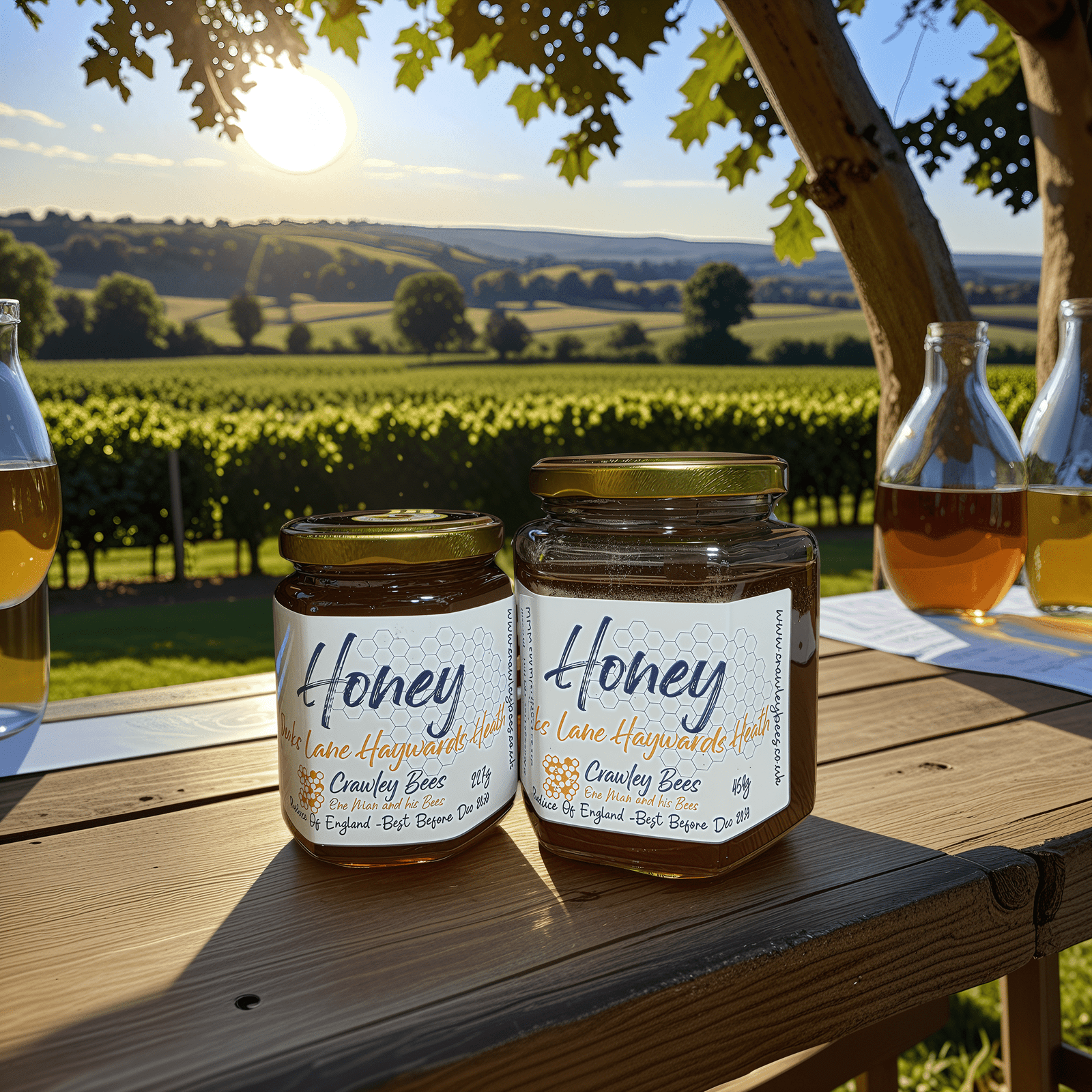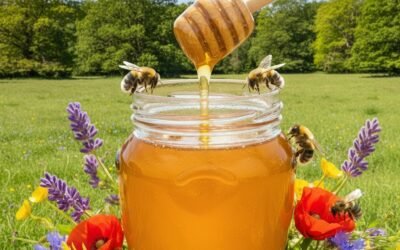What Makes Raw Honey So Special?
When you think of “raw honey,” what comes to mind? It’s honey that hasn’t been heated above the natural temperature of the hive and is as close to what the bees created as possible—pure, simple, and packed with natural goodness.
What Does “Raw” Really Mean?
Let’s break it down. “Raw” honey refers to how it’s handled after it leaves the hive. For honey to be considered raw, it must never be heated above the natural beehive temperature, around 35°C. This gentle treatment is key because heat can damage the beneficial compounds found in honey.
Raw honey keeps all the good stuff intact—natural enzymes, pollen, amino acids, and antioxidants. These are often lost during the pasteurisation process that most supermarket honey undergoes, which is why raw honey usually has a richer, creamier texture and more complex flavour.
Think of regular supermarket honey like clear, processed apple juice, while raw honey is like fresh, cloudy juice straight from the orchard—unfiltered, unheated, and full of character.
How Is Raw Honey Different from Regular Honey?
If you’ve ever stood in a shop staring at a wall of honey jars, you know it can be confusing. The secret to understanding what you’re buying is knowing what happens—or doesn’t happen—between the hive and your kitchen.
Regular supermarket honey is designed for a long shelf life and a perfectly uniform, clear look. To achieve this, it’s almost always pasteurised (heated to high temperatures) and then filtered very finely. This process removes yeast and prevents crystallisation, but also strips out nearly all the pollen, natural enzymes, and antioxidants.
Raw honey, on the other hand, is all about minimal processing. It’s never heated to the point of pasteurisation, so those delicate natural compounds are preserved. It’s usually strained to remove bits of wax, but not so much that it loses the beneficial bee pollen and propolis. That’s why raw honey is often a bit cloudy and will eventually crystallise—a natural sign of purity.
The Science Behind Raw Honey’s Health Benefits
Raw honey isn’t just a delicious way to sweeten your porridge—it’s a functional food, full of active compounds that offer real, science-backed health benefits. The secret lies in keeping it raw and unprocessed.
Most honey you find in supermarkets has been pasteurised, making it look smooth and uniform but destroying many of its most valuable components. Raw honey, however, is left just as the bees made it, preserving a complex mix of natural goodies.
One of honey’s most famous qualities is its ability to fight bacteria, thanks to specific elements like bee defensin-1 (a special protein from the bees’ immune system), its naturally low pH, and minimal water content—all creating an environment where bacteria can’t thrive.
A Rich Source of Protective Antioxidants
Raw honey is also packed with antioxidants—your body’s personal bodyguards against cell damage and ageing. The main antioxidant heroes in raw honey are:
- Flavonoids: Powerful plant compounds with antioxidant and anti-inflammatory properties.
- Phenolic Acids: These give honey its unique colour and flavour and help protect against oxidative stress.
So, when you add a spoonful of raw honey to your tea, you’re not just sweetening it—you’re giving your body a natural boost of protection.
More Than Just a Sweet Treat
Raw honey is great for digestion and soothing common winter bugs. Because it hasn’t been heated, it keeps its natural enzymes, which can help your body digest other foods and support gut health.
It’s also a brilliant, time-tested remedy for sore throats and coughs. Its thick, syrupy texture coats the throat, providing instant relief. Studies have even shown it can be as effective as some over-the-counter cough syrups (but always avoid giving honey to babies under one year old).
From ancient wound care to modern gut health, raw honey’s benefits are both tangible and practical—a perfect example of how a simple, natural food can play a powerful role in a healthy lifestyle.
How to Choose Authentic Raw Honey in the UK
Spotting the real deal is easy once you know what to look for. Think of it like choosing a good loaf of artisan bread—you want character and quality, not perfect uniformity.
Reading the Visual Clues
Genuine raw honey is almost never crystal clear. It tends to look cloudy or opaque, thanks to tiny particles of pollen, propolis, and beeswax. This is all the good stuff that gets stripped out of highly processed honey.
And if you see a jar that’s turned solid or crystallised, don’t worry! Crystallisation is a natural process and a sign of authentic, unheated honey. To return it to a runny state, just pop the jar in a bowl of warm water (not too hot) and give it a gentle stir.
Understanding the Importance of the Source
The flavour, colour, and even the texture of raw honey all come down to the flowers the bees visited. When choosing a jar, think about the kind of flavours you enjoy:
- Heather Honey: Dark and aromatic, with a memorable, slightly bitter finish.
- Clover Honey: Light in colour, mild, sweet, and floral.
- Borage Honey: Pale and delicate, with a subtle flavour.
Discovering these different floral varieties is one of the joys of buying from local beekeepers. Many small-scale producers, like Crawley Bees, offer single-origin honeys that capture the unique taste of a specific place and season.
Using Raw Honey in Your Kitchen
Raw honey is more than just something to spread on toast. Its versatility is incredible, but the trick is to use it in ways that protect its delicate nutrients and enzymes.
The golden rule? Avoid high heat. Heat is the enemy of all the good stuff in raw honey.
Think of it less as a cooking sugar and more as a finishing touch. Add it after the heat is off to preserve its complex notes and health benefits. Here are a few ideas:
- Morning Boost: Stir into warm (not boiling) porridge or swirl through Greek yoghurt.
- Dressings: Whisk into a vinaigrette with olive oil, lemon, and mustard.
- Healthy Snacks: Use as a binder for no-bake energy bars with oats, seeds, and nuts.
For warm dishes, add raw honey right at the end—like tossing roasted veggies in a honey glaze once they’re out of the oven, or brushing it on grilled chicken just before serving.
How Your Honey Choice Supports Local Bees and the Environment
When you buy raw honey from a local beekeeper, you’re doing more than just choosing a sweetener. You’re supporting the delicate balance of local ecosystems and the health of our pollinators.
Bees are the unsung heroes of our food system, responsible for pollinating around one-third of our food. Supporting local beekeepers, like Crawley Bees, helps maintain healthy, thriving bee populations that are crucial for the UK’s biodiversity and food security.
Your purchase is more than a transaction—it’s an investment in the future of our pollinators, local landscapes, and ethical producers.
Common Questions About Raw Honey
- My honey has gone solid—has it gone off?
Not at all! Crystallisation is a natural sign that you’ve got real, raw honey. To make it runny again, just warm the jar gently. - Is it safe to give raw honey to my baby?
No. Never give honey (raw or processed) to a child under one year old due to the risk of infant botulism. - Is honey vegan?
Honey is classified as an animal product, so strict vegans avoid it, though some people who follow a plant-based diet make exceptions for local, ethical honey.
At Crawley Bees, we’re passionate about honey that’s as pure and natural as the Sussex countryside it comes from. Ready to taste the difference? Explore our range of local raw honey and discover something truly special.



0 Comments